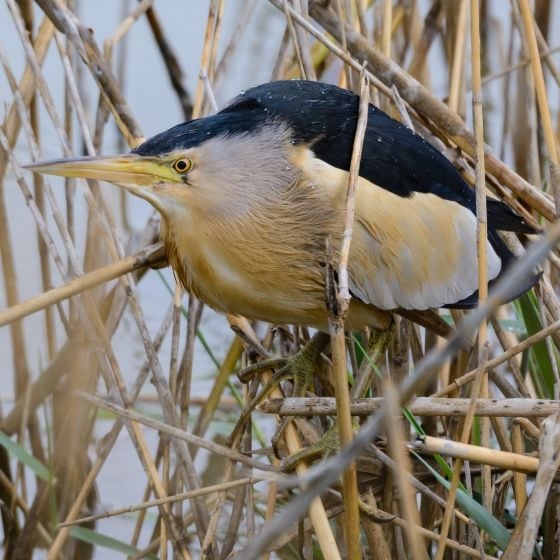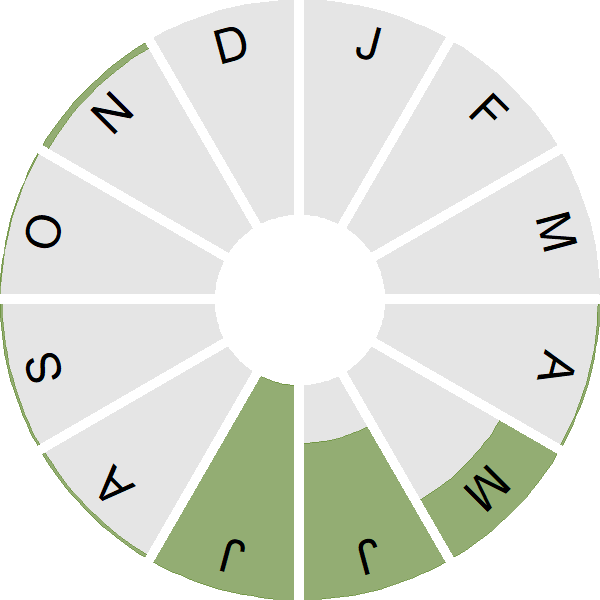Little Bittern

Introduction
Despite the now annual handful of breeding attempts, the Little Bittern remains a rare visitor to our shores.
This is a very small member of the heron family, about the size of a pigeon. Both sexes have a white wing panel, the male with black upperparts, the female brown. Little Bitterns migrate to Britain & Ireland in spring with most recorded from April. They return to Africa in the autumn.
The Little Bittern is a secretive and crepuscular species, which, together with the preferred reedbed habitat, makes this a very difficult species to observe and survey.

Key Stats
Identification
Songs and Calls
Song:
Status and Trends
Conservation Status
Population Size
Population Change
The status of the Little Bittern as a breeding species remains uncertain after a sequence of breeding records from 2009 to 2017 in Somerset were followed by a blank year in 2018, but a calling male was again present in 2019 (Eaton et al. 2021). The species is highly secretive and thus difficult to monitor
Distribution
In addition to being rare migrants, Little Bitterns have recently bred in Somerset.
Occupied 10-km squares in UK
2008–11
or view it on Bird Atlas Mapstore.
European Distribution Map
Distribution Change
Change in occupied 10-km squares in the UK
from 1981–84 to 2007–11
or view it on Bird Atlas Mapstore.
from 1968–72 to 2008–11
or view it on Bird Atlas Mapstore.
Seasonality
Little Bitterns are rare summer overshoot migrants and occasional breeders.
Weekly pattern of occurrence
The graph shows when the species is present in the UK, with taller bars indicating a higher likelihood of encountering the species in appropriate regions and habitats.

Movement
Britain & Ireland movement
European movements
EuroBirdPortal uses birdwatcher's records, such as those logged in BirdTrack to map the flows of birds as they arrive and depart Europe. See maps for this species here.
The Eurasian-African Migration Atlas shows movements of individual birds ringed or recovered in Europe. See maps for this species here.
Biology
Survival and Longevity
Survival is shown as the proportion of birds surviving from one year to the next and is derived from bird ringing data. It can also be used to estimate how long birds typically live.
Classification, names and codes
Classification and Codes
- Order: Pelecaniformes
- Family: Ardeidae
- Scientific name: Botaurus minutus
- Authority: Linnaeus, 1766
- BTO 2-letter code: LL
- BTO 5-letter code: LITBI
- Euring code number: 980
Alternate species names
- Catalan: martinet menut comú
- Czech: bukácek malý
- Danish: Dværghejre
- Dutch: Woudaap
- Estonian: väikehüüp
- Finnish: pikkuhaikara
- French: Blongios nain
- Gaelic: Corra-ghràin-bheag
- German: Zwergdommel
- Hungarian: törpegém
- Icelandic: Rindilþvari
- Irish: Bonnán Beag
- Italian: Tarabusino
- Latvian: mazais dumpis
- Lithuanian: mažasis baublys
- Norwegian: Dvergrørdrum
- Polish: baczek (zwyczajny)
- Portuguese: garçote
- Slovak: buciacik mociarny
- Slovenian: capljica
- Spanish: Avetorillo común
- Swedish: dvärgrördrom
- Welsh: Aderyn Bwn Lleiaf
Research
Causes of Change and Solutions
Causes of change
This species may be in the early stages of colonising the UK. The drivers of change are unclear and specualtive but climate change may have prompted range expansion and the creation of reedbed habitat within the UK for other species has ensured that suitable habitat is available.
More Evidence
More evidence from Conservation Evidence.com
Partners
Citing BirdFacts
If you wish to cite particular content in this page (e.g. a specific value) it is best to use the original sources as linked in the page. For a more general citation of the whole page please use: BTO (20XX) BirdFacts Species: profiles of birds occurring in the United Kingdom. BTO, Thetford (www.bto.org/birdfacts, accessed on xx/xx/xxxx).

